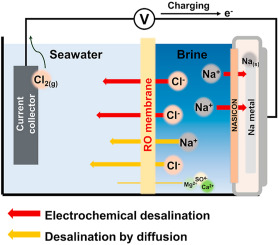Seawater battery desalination with a reverse osmosis membrane for simultaneous brine treatment and energy storage
- Journal
- Journal of Cleaner Production
- Vol
- 233
- Page
- 130188
- Year
- 2022
As it is typically disposed of to the ocean, naturally produced brine water has been an avoidable issue in seawater desalination technology, particularly in the reverse osmosis (RO) process. To address this issue, a seawater battery-desalination (SWB-D) system was used to reduce the concentration of RO brine while also storing electrical energy by harvesting sodium ions from the brine. The SWB equipped with an anion exchange membrane (AEM) can lower the RO brine concentration to seawater levels, but the use of AEM for brine treatment is costly and the slow kinetics of salt transport require long operation times. In this study, we present a proof of concept for using RO membrane as an alternative to AEM in the SWB desalination system. Owing to its low cost and unexpected support for salt removal via diffusion across the RO membrane, using RO membrane is a viable application. The effect of diffusion enables SWB-D with RO membrane to reduce the charging time by 36.8% (up to ∼40.5% salt removal) compared with SWB-D with AEM. In addition, ∼52.5 kWh m−3 of energy (assuming 80% energy recovery) was saved while lowering the concentration of brine to seawater levels (from 1.2 to ∼0.6 M).

